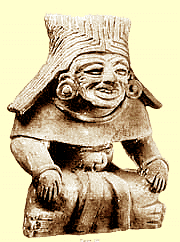
Baranamtarra
Hatshepsut
Puduhepa
Kandake Amanitore
Himiko
Boudicca
the Trung Sisters
Dahia al-Kahina
Lubluban
Makeda-be
Tomyris
Ruwej
Sondok of Silla
Lakkadevi
Judith the Fire
Mama Huaco
Abla Pokou
Nanyehi
María Candelaria
Cécile Fatiman
Gabriella Silang
Sarrouania of Azna
Maria Stewart
the Rani of Jhansi
Louise Michel
Lozen
Nehanda Nyakasikana
Qiu Chin
Niuta Teilelboim
Lillian Ngoya
Clan Mothers, Culture-Makers, Elders
Stone images of women are not only common in the mound temples of southern Appalachia, in some areas they are the primary representations. Unfortunately, massive looting of burial sanctuaries has caused many of these ancestral images to disappear into the private collections of settler families, and those in museums have been severed from their historic context, sometimes lacking even geographic identifiers. But historical accounts show that women in these southeastern societies had considerable social power, in some cases including women's councils with the power to veto declarations of war.
A medieval painting of Vietnamese women drummers is inscribed with the legend "Country of Women" in Chinese characters. We have it on good authority that there were men in Vietnam, but the deeply patriarchal thinking of the colonial rulers could not quite grasp the egalitarian cultures that prevailed in many parts of the country. The highland regions especially preserved matrilineal and/or matrilocal cultures, courtship by women, and other female-positive customs.
The women of Minangkabau in western Sumatra walk with a dignity that reflects a social system built around mother-right (adat ibu, "mother tradition") and women's ceremonies. Land is passed from mothers to daughters. Husbands come to live with their wives' families (matrilocality) but retain ties with their own matrilineage.

